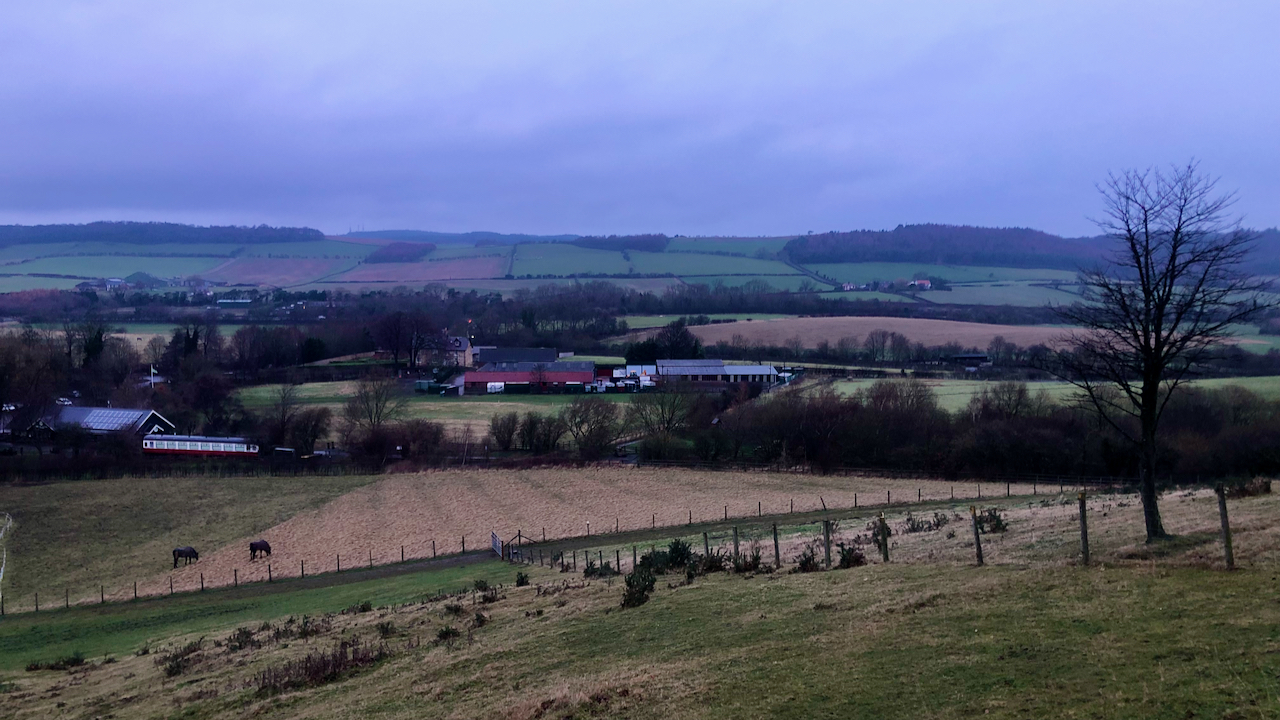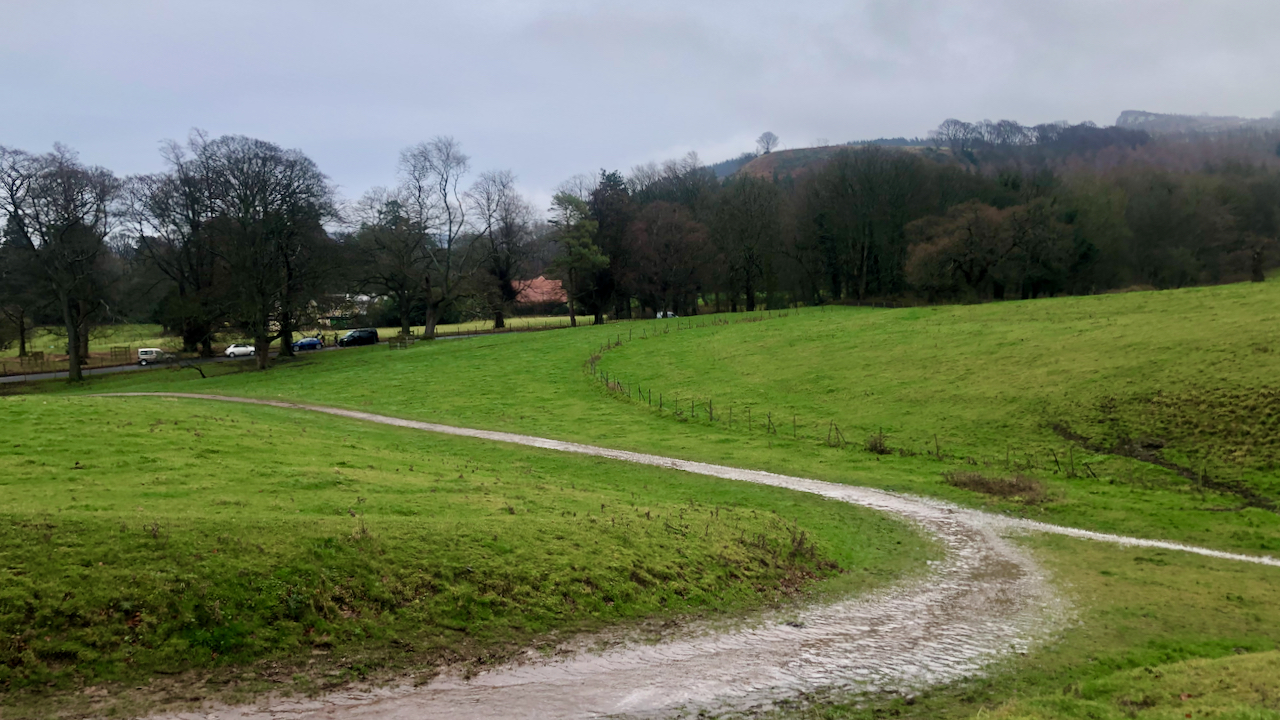A miserable morning so I thought I had better take a photo or two before venturing up into the gloom.
The old Ordnance Survey map shows a “Leper Hospital (Site of) A.D. 1392” to the left of centre within the curve of the track1Maps.nls.uk. (2022). View map: Yorkshire XVII.SW (includes: Guisborough; Hutton Lowcross; Morton; Newton; Pinch… – Ordnance Survey Six-inch England and Wales, 1842-1952. [online] Available at: https://maps.nls.uk/view/100941656#zoom=5&lat=3357&lon=7483&layers=BT [Accessed 8 Jan. 2022].. This location is confirmed on the North York Moors Historical Environment Record map which records that “Buildings of a medieval leper hospital were recorded by an archaeological excavation in the 1960s and, while truncated by the route of a nineteenth century tramway, also survive as earthworks to the north and south of the route“2North York Moors National Park. (2022). HER No: 14293. [online] Available at: https://www.northyorkmoors.org.uk/discover/archaeology/her-map [Accessed 8 Jan. 2022]..
On the other hand, Historic England records that although these excavations revealed merely the remains of a post Medieval farmhouse, not a leper hospital3Heritagegateway.org.uk. (2012). Hob Uid: 27694. [online] Available at: https://www.heritagegateway.org.uk/Gateway/Results_Single.aspx?uid=664a9a77-e2f8-4c83-a128-bc9a66cea37b&resourceID=19191 [Accessed 8 Jan. 2022].. It is noted however that sculptured stones have been identified within the outer walls of the house and stables at Hutton Home Farm (just out of shot to the left of the photo) which could possibly have come from a church attached to the hospital. Graves, writing in l808, refers to parts of the building being converted into a farmhouse4Graves, John. “The History of Cleveland, in the North Riding of the County of York: Comprehending an Historical and Descriptive View of the Ancient and Present State of Each Parish Within the Wapontake of Langbargh; the Soil, Produce, and Natural Curiosities; with the Origin and Genealogy of the Principal Families Within the District Front Cover”. Page 432. F. Jollie and sons, 1808. Available online at: https://books.google.co.uk/books?id=9UQQAAAAYAAJ&vq=leper&pg=PA432#v=snippet&q=leper&f=false.
All so confusing. Even the Historic England records themselves are contradictory, one entry putting the site near Mirey Close although I suspect this may be an error in the grid reference5Heritagegateway.org.uk. (2012). Hob Uid: 27576. [online] Available at: https://www.heritagegateway.org.uk/Gateway/Results_Single.aspx?uid=c178f767-9966-4076-9145-7c92ab769a9b&resourceID=19191 [Accessed 8 Jan. 2022].. The record states that a Leper Hospital did exist at Hutton until 1218-1234, when it moved to Lowcross, the new hospital receiving most of its lands from a hospital at Upsall.
So where was the site?
Local historian Grace Dixon, after studying the various charters, concludes that the location was close to the junction of the boundaries of Barnaby, Hutton and Pinchinthorp, where the present Lowcross Farm is located6“Guisborough Before 1900”. Edited by B.J.D. Harrison and G. Dixon. Page 18. 1982. ISBN 0 9507827 0 X.7Dixon, Grace. “Two Ancient Townships – Studies of Pinchinthorpe and Hutton Lowcross”. Page 47. 1991. ISBN 0 9507827 2 6..

One other interest of note is that there was once a Cistercian nunnery in Hutton in the late 12th-century. These were the ‘naughty’ nuns of Nunthorpe, who briefly set up shop here before being ordered to move to Baysdale in 1189, see a previous post8Out and about … (2020). Baysdale Abbey Bridge. [online] Available at: http://www.fhithich.uk/?p=24214 [Accessed 8 Jan. 2022]..
Perhaps the hospital was originally established in the buildings vacated by the nuns.
The last documentary mention of a hospital at Lowcross was in 1339.
The conventional view of leprosy, a disease affecting the skin, bones, eyes, nerves and respiratory tract, is that sufferers were stigmatised and outcast from society. The latest thinking is that this is largely a Victorian interpretation and that, in the Medieval period, leprosy sufferers may have been actually revered in the belief they had been specially selected by God to undergo the pains of purgatory here on earth; almost Christlike suffering9Gone Medieval podcast. Leprosy in the Middle Ages. (2022). [online] Available at: https://podfollow.com/gone-medieval/episode/03e83ebec0cc205d10ea7b18767c40ffb31a5170/view [Accessed 8 Jan. 2022]..
- 1Maps.nls.uk. (2022). View map: Yorkshire XVII.SW (includes: Guisborough; Hutton Lowcross; Morton; Newton; Pinch… – Ordnance Survey Six-inch England and Wales, 1842-1952. [online] Available at: https://maps.nls.uk/view/100941656#zoom=5&lat=3357&lon=7483&layers=BT [Accessed 8 Jan. 2022].
- 2North York Moors National Park. (2022). HER No: 14293. [online] Available at: https://www.northyorkmoors.org.uk/discover/archaeology/her-map [Accessed 8 Jan. 2022].
- 3Heritagegateway.org.uk. (2012). Hob Uid: 27694. [online] Available at: https://www.heritagegateway.org.uk/Gateway/Results_Single.aspx?uid=664a9a77-e2f8-4c83-a128-bc9a66cea37b&resourceID=19191 [Accessed 8 Jan. 2022].
- 4Graves, John. “The History of Cleveland, in the North Riding of the County of York: Comprehending an Historical and Descriptive View of the Ancient and Present State of Each Parish Within the Wapontake of Langbargh; the Soil, Produce, and Natural Curiosities; with the Origin and Genealogy of the Principal Families Within the District Front Cover”. Page 432. F. Jollie and sons, 1808. Available online at: https://books.google.co.uk/books?id=9UQQAAAAYAAJ&vq=leper&pg=PA432#v=snippet&q=leper&f=false
- 5Heritagegateway.org.uk. (2012). Hob Uid: 27576. [online] Available at: https://www.heritagegateway.org.uk/Gateway/Results_Single.aspx?uid=c178f767-9966-4076-9145-7c92ab769a9b&resourceID=19191 [Accessed 8 Jan. 2022].
- 6“Guisborough Before 1900”. Edited by B.J.D. Harrison and G. Dixon. Page 18. 1982. ISBN 0 9507827 0 X.
- 7Dixon, Grace. “Two Ancient Townships – Studies of Pinchinthorpe and Hutton Lowcross”. Page 47. 1991. ISBN 0 9507827 2 6.
- 8Out and about … (2020). Baysdale Abbey Bridge. [online] Available at: http://www.fhithich.uk/?p=24214 [Accessed 8 Jan. 2022].
- 9Gone Medieval podcast. Leprosy in the Middle Ages. (2022). [online] Available at: https://podfollow.com/gone-medieval/episode/03e83ebec0cc205d10ea7b18767c40ffb31a5170/view [Accessed 8 Jan. 2022].

Leave a Reply